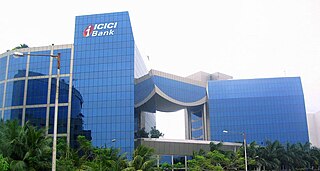
State Bank of India (SBI) is an Indian multinational public sector bank and financial services statutory body headquartered in Mumbai, Maharashtra. It is the 48th largest bank in the world by total assets and ranked 178th in the Fortune Global 500 list of the world's biggest corporations of 2024, being the only Indian bank on the list. It is a public sector bank and the largest bank in India with a 23% market share by assets and a 25% share of the total loan and deposits market. It is also the tenth largest employer in India with nearly 250,000 employees. In 2024, the company’s seat in Forbes Global 2000 was 55.

Bank of Baroda is an Indian government Public sector bank headquartered in Vadodara, Gujarat. It is the third largest public sector bank in India after State Bank of India. Based on 2023 data, it is ranked 586 on the Forbes Global 2000 list.

Punjab National Bank is an Indian government public sector bank based in New Delhi. It was founded in May 1894 and is the second-largest public sector bank in India in terms of its business volumes, with over 180 million customers, 12,248 branches, and 13,000+ ATMs.

Indian Bank is an Indian public sector bank, established in 1907 and headquartered in Chennai. It serves over 100 million customers with 40,187 employees, 5,847 branches with 4,937 ATMs and Cash deposit machines. Total business of the bank has touched ₹1,221,773 crore (US$150 billion) as of 31 March 2024.

ICICI Bank Limited is an Indian multinational bank and financial services company headquartered in Mumbai with a registered office in Vadodara. It offers a wide range of banking and financial services for corporate and retail customers through various delivery channels and specialized subsidiaries in the areas of investment banking, life, non-life insurance, venture capital and asset management.

State Bank of Mysore was a Public Sector bank in India, with headquarters at Bangalore. It was one of the five associate banks of State Bank of India, all of which were consolidated with the State Bank of India with effect from 1 April 2017.

Modern banking in India originated in the mid of 18th century. Among the first banks were the Bank of Hindustan, which was established in 1770 and liquidated in 1829–32; and the General Bank of India, established in 1786 but failed in 1791.
Canara Bank is an Indian public sector bank based in Bangalore, India. Established in 1906 at Mangalore by Ammembal Subba Rao Pai. The bank was nationalized in 1969. Canara Bank also has offices in London, Dubai and New York.
The state of Karnataka, particularly the coastal districts of Dakshina Kannada and Udupi, historically and collectively known as South Canara, is called the cradle of banking in India. This is because seven of the country's leading banks, Canara Bank, Syndicate Bank, Corporation Bank, Vijaya Bank, Karnataka Bank, Vysya Bank and the State Bank of Mysore originated from this state. The first five in the above list of banks were established in the districts of Udupi and Dakshina Kannada. These districts have one among the best distribution of banks in India - a branch for every 500 persons. Between 1880 and 1935, 22 banks were established in coastal Karnataka, nine of them in the city of Mangalore.

Regional Rural Banks (RRBs) are government owned scheduled commercial banks of India that operate at regional level in different states of India. These banks are under the ownership of Ministry of Finance, Government of India, Sponsored Bank and concerned State Government in the ratio of 50:35:15 respectively. They were created to serve rural areas with basic banking and financial services. However, RRBs also have urban branches.
Public Sector Undertakings (Banks) are a major type of government-owned banks in India, where a majority stake (i.e., more than 50%) is held by the Ministry of Finance (India) of the Government of India or State Ministry of Finance of various State Governments of India. The shares of these government-owned-banks are listed on stock exchanges. Their main objective is social welfare.

Andhra Pragathi Grameena Bank is a Regional Rural Bank in India. It was established in 2006 as a Scheduled Commercial Bank as per Regional Rural Banks Act of 1976 to provide banking facilities in Ananthapuram, Sri Sathya Sai, Annamayya, Kadapa, Kurnool, Nandyal, Tirupati, Nellore, Bapatla and Prakasam districts of Andhra Pradesh. It is under the ownership of Ministry of Finance, Government of India

Kerala Gramin Bank (KGB) is an Indian regional rural bank (RRB), headquartered in Malappuram, Kerala. Like other RRBs, the Government of India holds the majority 50% shares, while the Kerala state government holds 15% and Canara Bank owns the remaining 35% stake.

The Karnataka Vikas Grameena Bank (KVGB), an Indian Regional Rural Bank sponsored by Canara Bank. It is under the ownership of Ministry of Finance, Government of India. The bank provides retail banking services to rural users and has 629 branches in areas of Karnataka, around North and Western Karnataka.
Bandhan Bank Ltd. is a banking and financial services company, headquartered in Kolkata.
Kaveri Grameena Bank was a Regional Rural Bank established under Regional Rural Banks' Act 1976, was a Scheduled Bank jointly owned by Government of India, State Bank of India and Government of Karnataka, permitted to carry all kinds of banking business. The Bank was operating in 22 Districts of South Karnataka, having its Head Office at Bellary City with Nine Regional Offices at Mysuru, Mandya, Bengaluru, Tumakuru, Hassan, Chamarajanagar, Madikeri, Chikmagulur and Ramanagara etc.
Ujjivan Small Finance Bank Limited is an Indian small finance bank based in Bangalore, which commenced operations on 1 February 2017. Ujjivan Financial Services holds an 80 percent stake in the bank.

AU Small Finance Bank Limited is an Indian scheduled commercial small finance bank and India’s largest tech-led small finance bank, based in Jaipur. It was founded as vehicle finance company and NBFC, AU Financiers (India) Ltd in 1996 and converted into a full-fledged small finance bank on 19 April 2017.
Pragathi Gramin Bank was an Indian Regional Rural Bank (RRB) established under Regional Rural Banks' Act 1976. The bank was permitted to carry all kinds of banking business and provided banking services to individuals and small businesses.















